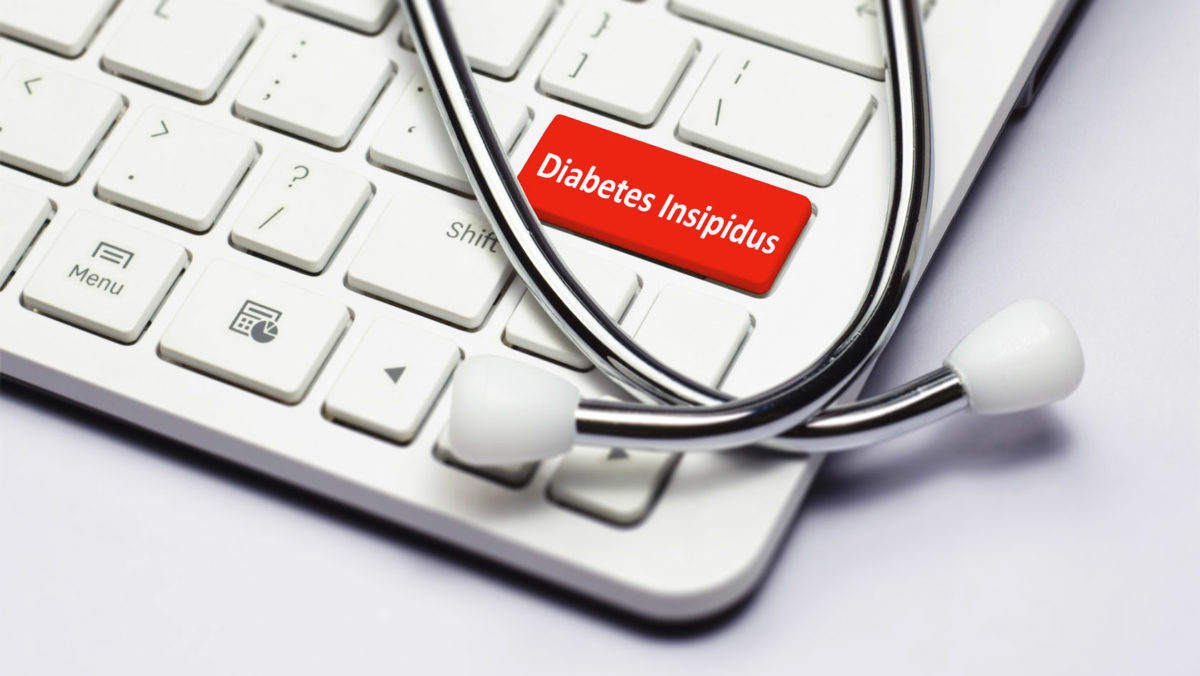If you imagine you have been in the desert for days, and so thirsty and so dry. I can drink and drink and drink, and still cannot drink enough to fix that thirst”, says Mary, of Wellington, who developed diabetes insipidus after surgery to remove a pituitary tumour.
When we hear the word “diabetes”, most of us think of diabetes mellitus (DM) – the group of diseases related to how the body handles glucose. Diabetes insipidus (DI) is not related to glucose, and thus is often misunderstood or forgotten.
DI is a rare disease with a prevalence of just 30 people per million.1 In comparison, DM (which includes type 1, type 2 and gestational diabetes) is increasingly common, with more than 260,000 people diagnosed in New Zealand in 20192 – more than five per cent of the population.
Why do these two very different diseases share the same name? The word “diabetes” is the Greek word for siphon, and is used for both conditions because people with diabetes pass water like a siphon. “Mellitus” is the Latin word for sweet, describing the presence of glucose in the urine of patients with DM. In contrast, patients with DI have insipid, tasteless urine.
Recognising DI
Passing large amounts of dilute urine and an insatiable thirst are the hallmark symptoms of DI. Patients describe a thirst that can only be quenched by drinking ice-cold drinks and often need to go to the toilet several times an hour throughout the day and night.
A typical DI patient wakes up multiple times during the night to pass urine and drink large volumes of fluids. Therefore, a useful diagnostic tool is measuring urine output over 24 hrs. In severe cases, a person with DI can pass up to 20 litres of urine in a day.
Passing such large quantities of urine is due to problems with a vital hormone called anti-diuretic hormone (ADH), also known as vasopressin. ADH is a life-essential hormone made by the hypothalamus in the brain and stored in the posterior pituitary gland. It regulates the amount of water and electrolytes in the bloodstream.
A decrease in blood volume or increase in the concentration of salts in the bloodstream, eg in dehydration, is detected by special sensors in the hypothalamus. This stimulates release of ADH from the pituitary gland. High levels of ADH act on the kidneys to reabsorb water back into the body, resulting in concentrated urine. Conversely, when one drinks a lot of fluids and is well hydrated, ADH secretion decreases, resulting in dilute urine.
In ADH deficiency, water passing through the kidney tubules cannot be reabsorbed back into the body. Therefore the patient will develop polyuria, passing large amounts of dilute urine. If untreated, this can quickly lead to dehydration, hypernatraemia (high blood sodium levels), and be potentially fatal.
Types of DI
There are two main forms of DI. Central DI (also known as cranial or neurogenic DI) results from decreased ADH production by the hypothalamus or reduced ADH release by the pituitary gland. Central DI is caused by damage to the hypothalamus or pituitary gland, eg after pituitary surgery.
The other type, nephrogenic DI, occurs when the kidneys do not respond appropriately to ADH. Nephrogenic DI may be genetic or acquired.
Call for a name change
In October 2020, the UK Pituitary Foundation ran a “No Need to DI” awareness campaign3 and collected more than 5000 signatures calling for a name change for this condition. UK Pituitary Foundation CEO Menai Owen-Jones said, “Clearly, anything is better than diabetes insipidus, to get rid of that word [diabetes]”. Mary agrees. “I have had a lot of nurses wanting to check my blood sugar. Last time I went into hospital, a nurse came in with the blood sugar test kit and said I’m going to check your blood sugars. Another time the nurse came in and asked how often do you check your blood sugars. I had to explain that no, I don’t have sugar diabetes”.
Patients like Mary often worry they will not receive appropriate treatment for DI if they are too unwell to speak for themselves. Therefore a MedicAlert bracelet is advised, and an emergency leaflet explaining their condition and the treatment required should be with them at all times.
Diabetes insipidus: top tips for nurses
- Diabetes insipidus (DI) has nothing to do with diabetes mellitus (“sugar diabetes”).
- Call the endocrinology team for help early.
- Do a fluid balance chart to monitor fluid input and output.
- DI is potentially life-threatening. Desmopressin medication (eg DDAVP nasal spray) is life essential.
Wellington Regional Hospital endocrinologist Richard Carroll agrees the terminology is confusing. “I think there is a real need for a bit of a rethink, whether the terminology is appropriate nowadays, and whether we should be using terminology that is not as confusing as it is currently.”
Changing the name of a disease is not simple and requires international buy-in. Interestingly, the latest version of the International Classification of Diseases (ICD-11), published by the World Health Organization (WHO), has added “ADH (anti-diuretic hormone secretion) deficiency”4 as an alternative for “central diabetes insipidus”. Other suggested names include pituitary insipidus and vasopressin deficiency.
Treatment of DI (ADH deficiency)
Once an endocrinologist diagnoses the condition, treatment is readily available. Desmopressin, a synthetic form of vasopressin, is sold under the trade name DDAVP, among others.
Various formulations of desmopressin are available, including nasal sprays, sublingual melts, oral tablets, and injections. These are all available and fully subsidised in New Zealand.
The most commonly used form is the desmopressin nasal spray. This medication works within minutes and is very effective. The currently funded brand, Desmopressin PH&T nasal spray, does require refrigeration when unopened. However, it can be kept at room temperature after opening for up to two months.
Nurses need to recognise that desmopressin nasal spray is a life-sustaining therapy. (There are very few life-sustaining medications – one being insulin in type 1 diabetics, a second is hydrocortisone for those with adrenal insufficiency, and the third is desmopressin for those with DI.) Therefore, especially when a patient with DI is an inpatient, desmopressin must be promptly charted, ordered from the pharmacy, and given to the patient as prescribed.
Patients with DI need to drink to thirst at all times and are advised to have a “breakthrough” regularly. A breakthrough is the recurrence of symptoms such as thirst and frequency urination when the effect of desmopressin wears off. Regular breakthrough (briefly stopping DDAVP) is needed because using too much desmopressin leads to water retention and low blood sodium levels (hyponatraemia), which can be challenging to treat.
Problems arise when a patient ends up in a hospital unwell, particularly if they are unconscious – the risk increases when they cannot drink to thirst or are given IV fluids. “Electrolyte disturbances can get very complex, very quickly”, says Carroll.
A fluid balance chart to monitor all fluid input and output is necessary for these circumstances. “Given the complexity, it requires an individual approach, and getting the endocrine team in there quickly is important,” Carroll says.
Nurses must recognise DI is a potentially life-threatening condition, and desmopressin is a life-sustaining medication. If a patient misses their medication, they will rapidly lose a large amount of fluid in the urine, which will lead to dehydration, high sodium levels in the blood (hypernatraemia), confusion and even death.
Next time you see a patient with DI, don’t automatically prick their finger to check their blood sugar. Instead, call the endocrine service and monitor their fluid balance.
Useful resources
- BMJ Podcast 2019 – Diabetes Insipidus – the danger of misunderstanding diabetes.
- No Need to DI Campaign – Patient Stories from the UK Pituitary Foundation 2020.
Catherine Chan, MBChB, FRNZCGP, is a GP at Ellerslie Medical Centre, and co-chair of the New Zealand Acromegaly Society.
References
- Khadori, R. (2020). What is the prevalence of diabetes insipidus (DI)? Medscape.
- Ministry of Health. (2020). Virtual Diabetes Register (VDR).
- The UK Pituitary Foundation. (2020). No Need to DI Campaign.
- World Health Organisation. (2021). 5A61.5 Central diabetes insipidus. ICD-11 International Classification of Diseases 11th Revision.
This article was reviewed by Georgina Casey, RN, BSc, PGDip Sc, MPhil Nursing, the director of cpd4nurses.co.nz.





